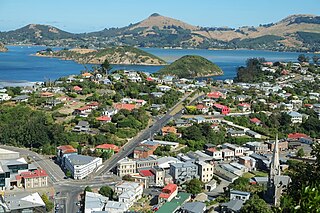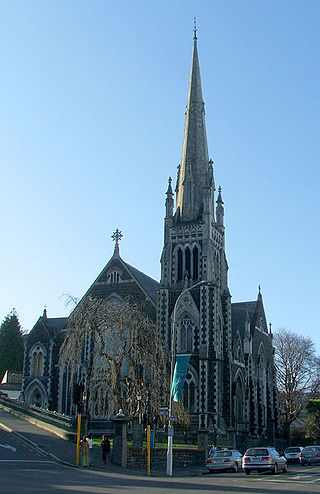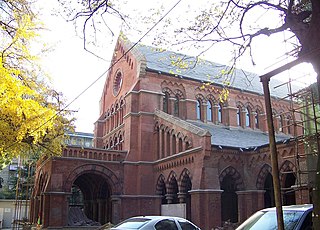
Dunedin is the second-largest city in the South Island of New Zealand, and the principal city of the Otago region. Its name comes from Dùn Èideann, the Scottish Gaelic name for Edinburgh, the capital of Scotland. The city has a rich Māori, Scottish, and Chinese heritage.

Port Chalmers is a town serving as the main port of the city of Dunedin, New Zealand. Port Chalmers lies ten kilometres inside Otago Harbour, some 15 kilometres northeast of Dunedin's city centre.

Lawrence is a small town in Otago, in New Zealand's South Island. It is located on State Highway 8, the main route from Dunedin to the inland towns of Queenstown and Alexandra. It lies 35 kilometres to the northwest of Milton, 11 kilometres northwest of Waitahuna, and close to the Tuapeka River, a tributary of the Clutha.
The Anglican Church in Aotearoa, New Zealand and Polynesia, formerly the Church of the Province of New Zealand, is a province of the Anglican Communion serving New Zealand, Fiji, Tonga, Samoa, and the Cook Islands. Since 1992 the church has consisted of three tikanga or cultural streams: Aotearoa, New Zealand, and Polynesia. The church's constitution says that, among other things, it is required to "maintain the right of every person to choose any particular cultural expression of the faith". As a result, the church's General Synod has agreed upon the development of the three-person primacy based on this three tikanga system. It has three primates (leaders), each representing a tikanga, who share authority.

The Port Chalmers Branch was the first railway line built in Otago, New Zealand, and linked the region's major city of Dunedin with the port in Port Chalmers. The line is still operational today.

The Diocese of Dunedin is one of the thirteen dioceses and hui amorangi of the Anglican Church in Aotearoa, New Zealand and Polynesia.
Trinity Catholic College is a Catholic, state-integrated, co-educational, secondary school located in central Dunedin, New Zealand. The school was founded in 1989 as the successor of several other secondary schools the oldest of which was founded in 1871. Trinity is the only Catholic secondary school in Dunedin and is open to enrolments from throughout the entire city. The school's proprietor is the Catholic Bishop of Dunedin.

St Joseph's Cathedral is the cathedral for the Roman Catholic Diocese of Dunedin. It is located in City Rise in the city of Dunedin, New Zealand. It serves as the seat of the bishop of the Latin Church Diocese of Dunedin, which was erected on 26 November 1869.

St Paul's Cathedral is an Anglican cathedral church located in the heart of The Octagon near the Dunedin Town Hall and hence Dunedin, New Zealand. The cathedral is the seat of the Bishop of Dunedin and the mother church of the Anglican Diocese of Dunedin.

Hanover Hall is a community arts centre and event venue in central in Dunedin, New Zealand, opened in 2018 as home to the Dunedin Symphony Orchestra. The building was built in 1912 as the Hanover Street Baptist Church, located in Hanover Street 1 kilometre (0.62 mi) northeast of the city centre, close to the Otago Medical School.

Knox Church is a notable building in Dunedin, New Zealand. It houses the city's second Presbyterian congregation and is the city's largest church of any denomination.

Edmund Giblett Allen (1844–1909) was a Liberal Party Member of Parliament in New Zealand.

All Saints' Church is a heritage-listed Anglican church located in Dunedin, New Zealand. Established in 1865, the church is part of the Dunedin North parish in the Diocese of Dunedin.

CSI-Holy Trinity Church is a church under the auspices of the Protestant Church of South India, a uniting Church. It is located in the Bolarum locality of Secunderabad Cantonment.

Holy Trinity Church, Shanghai, is a Protestant church in Huangpu District of Shanghai.

Rutherford Waddell (1850–1932) was a notable New Zealand Presbyterian minister, social reformer and writer. He was born in Ireland and after failing to finding a position as a missionary or a minister Waddell and his wife migrated to New Zealand in 1877. Settling in Dunedin he led St Andrew's Presbyterian Church for forty years from 1879 to 1919. An important liberalizing influence in the Presbyterian church in New Zealand he was an active believer in the value of the ministry to promote social justice. This led him to oversee the setting up a mission hall, savings bank, free library and free kindergarten within his parish, as well as promoting the founding of a variety of cultural and sporting groups.
Forward Movement is the name taken by a number of Christian Protestant movements in the United Kingdom, United States, Canada and other countries.

This list of works by Robert Lawson categorises and provides brief details of the structures designed by Scottish-born architect Robert A. Lawson (1833–1902) who is said did more than any other designer to shape the face of the Victorian era architecture of the city of Dunedin.

St Andrew’s Presbyterian Church was a prominent church in Dunedin, New Zealand. Designed by pre-eminent Dunedin Robert Lawson it was constructed in 1870 to serve a rapidly developing area of the city which became notorious for its slum housing, poverty and crime which led to it being referred to as the “Devil’s Half-Acre” from 1873 onwards. The church is best known for its long time crusading minister the Reverend Rutherford Waddell. Waddell’s ‘Sin of Cheapness’ sermon which was a landmark in New Zealand’s social and labour history was delivered from its pulpit. It eventually closed as a place of Presbyterian worship in 1978 and after briefly serving as a place of worship for the Word of Life Pentecostal Church it was purchased by the Coptic Orthodox Church in 2000, who renamed it the Archangel Michael Coptic Orthodox Church.


















